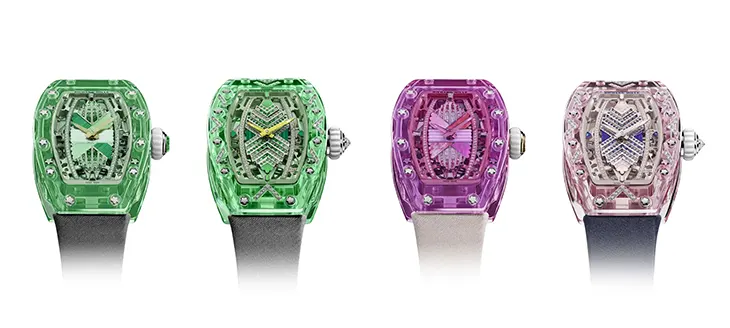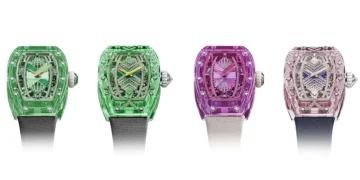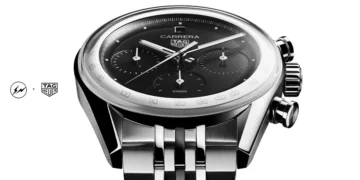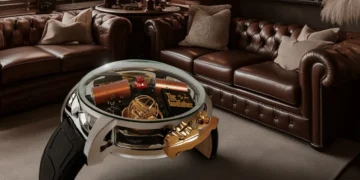
Known for pushing the boundaries of technique and design, Richard Mille has consistently proved that the future of watchmaking lies beyond convention. Nowhere is this more evident than in its pioneering use of sapphire, an extraordinary material that has opened entirely new horizons in both aesthetics and engineering. From the very first RM 056 Tourbillon Split-Seconds Chronograph Sapphire to the newly released RM 07-02 Automatic Sapphire models, the brand continues to demonstrate a relentless quest for novelty and excellence.
WATCHES
Revered for its radiance and transparency, sapphire is among the most in-demand materials in watchmaking today. However, a decade ago, Richard Mille stood almost alone in leveraging its potential for entire watch cases. This forward-thinking approach required investing significant resources into developing new techniques for milling and polishing sapphire—a challenge that not only required specialized machinery, but also demanded the utmost precision.
Ranking 9 on the Mohs scale of mineral hardness (just behind diamond), sapphire is remarkably impact- and scratch-resistant. Yet, it also retains a unique warmth to the touch, making it supremely comfortable on the wrist. This rare combination of ruggedness, visual clarity, and tactile pleasure underscores why sapphire is the perfect canvas to showcase Richard Mille’s most exclusive calibres.
While natural sapphire has been prized for centuries, watchmaking mainly relies on synthetic sapphire, which possesses the same chemical composition, physical properties, and crystalline structure. The advantage is that these synthetic blocks can be grown large enough to form the three-part cases of Richard Mille’s intricately curved watches. In partnership with Stettler AG of Switzerland, Richard Mille employs the Kyropoulos method, a process in which aluminum oxide is heated above 2,000°C and slowly grown around a small seed crystal over several weeks.
Such meticulous steps are only the beginning. Once the sapphire “boule” is formed, each case undergoes more than 1,000 hours of machining and polishing. With a hardness of approximately 2,000 Vickers, the material tolerates virtually no margin for error. This represents engineering at its most demanding, where the slightest deviation can compromise the sapphire’s optical purity or structural integrity.
Always pushing forward, Richard Mille soon began using sapphire for components within the movement itself—such as baseplates and bridges—then took another daring leap with colored sapphires. By meticulously incorporating metal oxides into the crystalline structure, the brand pioneered vibrant blue, green, orange, and pink sapphire cases. Though more sensitive to temperature and growth rates, these colored variants offer an entirely new visual dimension to the brand’s aesthetic language.
In 2015, Richard Mille introduced its first RM 07-02 Automatic Sapphire creations—a vivid showcase of sapphire’s potential, sometimes further enhanced by gem-set detailing. Today, the watchmaker expands on that legacy with four new limited-edition RM 07-02 models, including two green versions, a fuchsia pink, and an all-new lilac. Each case, still requiring over 1,000 hours of work, features a dazzling dial adorned with diamonds, hypnotic blue sapphires, vibrant yellow sapphires, orange spessartite, and various ornamental stones such as white agate and malachite.
At the core of these timepieces beats the CRMA5 in-house skeletonised automatic movement, displaying hours and minutes and offering approximately 50 hours of power reserve. Depending on the version, the baseplate and bridges are rendered in red or white gold, emphasizing the watch’s interplay of mechanical prowess and precious materials. Limitations in sapphire’s growth process further amplify their exclusivity: only seven timepieces per color—pink, lilac, green, and gem-set green—are being produced.
Richard Mille Sapphire Collection has turned what was once a niche curiosity into a defining element of modern watchmaking. The brand’s exploration of sapphire—transparent or colored—transcends mere aesthetics, revealing an unyielding dedication to technical innovation, precision, and craftsmanship.



















